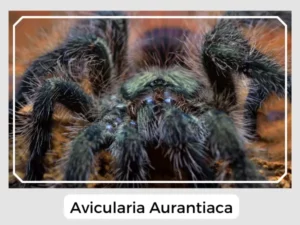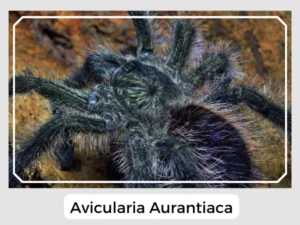The Avicularia aurantiaca is a unique kind of tarantula spider. It’s different from other spiders you might know. Curious about this spider? We’re here to tell you some fascinating facts about it.

Photo Credit: Michael Pankratz
The eggs of this species are laid inside a sac made of webbing.
Juveniles remain close to their mother until they are independent.
These spiders do not construct webs to catch prey.
Yes, Avicularia aurantiaca tarantulas have venom. They use it to help them catch and eat their food.
They can bite, but they’re often calm. Only if they feel really scared might they bite in defense. Most times, they just want to be left alone to do their spider things.

Photo Credit: Michael Pankratz
The Avicularia aurantiaca tarantula occupies a critical ecological niche in arboreal environments. By consuming insects, they control pest populations, providing an invaluable service to the ecosystem. Their arboreal habits also contribute to the dispersion of seeds and the pollination of flowers, albeit indirectly.
Natural Predators: In the wild, these tarantulas face threats from a variety of predators, including larger birds, mammals, and reptiles. Their urticating hairs offer some protection, but they can still fall prey to adept hunters.
Prey-Predator Dynamics: This tarantula species utilizes its venom to subdue prey effectively, demonstrating a fascinating aspect of the food web. Their predatory behavior aids in maintaining a balanced ecosystem by controlling the population of insects.
Relationship with Humans: Human interaction with Avicularia aurantiaca tarantulas is relatively rare, as they inhabit high in the tree canopies. When encountered, they are not aggressive towards humans and bites are uncommon. They are, however, a species of interest in the pet trade due to their calm demeanor and striking appearance.
| Lifespan | Not recorded |
| Distribution | Central and South America |
| Habitat | Arboreal environments |
| Diet | Insects |
In conclusion, the Avicularia aurantiaca tarantula is a notable arachnid that plays a significant role in its habitat.
The Avicularia aurantiaca is a unique kind of tarantula spider. It’s different from other spiders you might know. Curious about this spider? We’re here to tell you some fascinating facts about it.

Photo Credit: Michael Pankratz
The eggs of this species are laid inside a sac made of webbing.
Juveniles remain close to their mother until they are independent.
These spiders do not construct webs to catch prey.
Yes, Avicularia aurantiaca tarantulas have venom. They use it to help them catch and eat their food.
They can bite, but they’re often calm. Only if they feel really scared might they bite in defense. Most times, they just want to be left alone to do their spider things.

Photo Credit: Michael Pankratz
The Avicularia aurantiaca tarantula occupies a critical ecological niche in arboreal environments. By consuming insects, they control pest populations, providing an invaluable service to the ecosystem. Their arboreal habits also contribute to the dispersion of seeds and the pollination of flowers, albeit indirectly.
Natural Predators: In the wild, these tarantulas face threats from a variety of predators, including larger birds, mammals, and reptiles. Their urticating hairs offer some protection, but they can still fall prey to adept hunters.
Prey-Predator Dynamics: This tarantula species utilizes its venom to subdue prey effectively, demonstrating a fascinating aspect of the food web. Their predatory behavior aids in maintaining a balanced ecosystem by controlling the population of insects.
Relationship with Humans: Human interaction with Avicularia aurantiaca tarantulas is relatively rare, as they inhabit high in the tree canopies. When encountered, they are not aggressive towards humans and bites are uncommon. They are, however, a species of interest in the pet trade due to their calm demeanor and striking appearance.
| Lifespan | Not recorded |
| Distribution | Central and South America |
| Habitat | Arboreal environments |
| Diet | Insects |
In conclusion, the Avicularia aurantiaca tarantula is a notable arachnid that plays a significant role in its habitat.